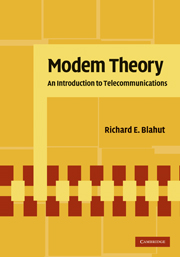Book contents
- Frontmatter
- Contents
- Preface
- Dedication
- 1 Introduction
- 2 Baseband Modulation
- 3 Baseband Demodulation
- 4 Sequences at Baseband
- 5 Passband Modulation
- 6 Passband Demodulation
- 7 Principles of Optimal Demodulation
- 8 Synchronization
- 9 Codes for Digital Modulation
- 10 Codes for Data Transmission
- 11 Performance of Practical Demodulators
- 12 Secure Communications
- Bibliography
- Index
8 - Synchronization
Published online by Cambridge University Press: 05 June 2012
- Frontmatter
- Contents
- Preface
- Dedication
- 1 Introduction
- 2 Baseband Modulation
- 3 Baseband Demodulation
- 4 Sequences at Baseband
- 5 Passband Modulation
- 6 Passband Demodulation
- 7 Principles of Optimal Demodulation
- 8 Synchronization
- 9 Codes for Digital Modulation
- 10 Codes for Data Transmission
- 11 Performance of Practical Demodulators
- 12 Secure Communications
- Bibliography
- Index
Summary
A channel may introduce unpredictable changes into the waveform passing through it. In a passband channel, such as a radio frequency channel, unpredictable phase shifts of the carrier may occur in the atmosphere, in antennas, and in other system elements or because of uncertainty in the time of propagation. In order to demodulate a digital waveform coherently, a coherent replica of the carrier is needed in the receiver. Because the receiver does not know the carrier phase independently of the received signal, the receiver must locally regenerate a coherent replica of the carrier. Uncertainty in the phase of the received waveform introduces the task of phase synchronization in the receiver.
Uncertainty in the time of propagation also introduces problems of time synchronization. The local clock must be synchronized with the incoming datastream so that incoming symbols and words can be correctly framed and assigned their proper indices. Time synchronization may be subdivided into two tasks: symbol synchronization, and block or frame synchronization. These two kinds of time synchronization are quite different. Symbol synchronization is a fine time adjustment that adjusts the sampling instants to their correct value. It exploits the shape of the individual pulses making up the waveform to adjust the time reference. The content of the datastream itself plays no role in symbol synchronization. Block synchronization takes place on a much longer time scale. It looks for special patterns embedded in the datastream so that it can find the start of a message or break the message into constituent parts.
- Type
- Chapter
- Information
- Modem TheoryAn Introduction to Telecommunications, pp. 251 - 298Publisher: Cambridge University PressPrint publication year: 2009



